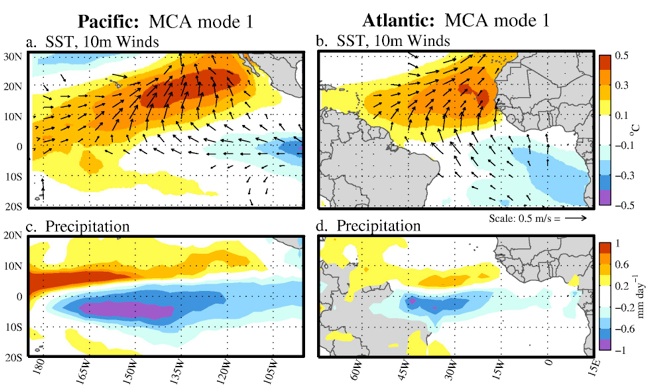Background

Figure 1 (from Chiang and Vimont 2004): Spatial structures associated with the Pacific (left) and Atlantic (right) Meridional Modes. The top panels show the regression of SST (shading) and 10m wind (vectors) onto the (a) Pacific and (b) Atlantic Meridional Mode SST time series (the SST expansion coefficient from Maximum Covariance Analysis). The bottom panels show the regression of precipitation onto the (c) Pacific and (d) Atlantic Meridional Modes.
Meridional modes are a source of tropical climate variability that exist due to coupling between the atmosphere and ocean. Chiang and Vimont (2004) identify the Pacific Meridional Mode (PMM) and Atlantic Meridional Mode (AMM) via applying Maximum Covariance Analysis to tropical sea surface temperature (SST) and low-level winds (see Figure 1). The resulting PMM and AMM structures are characterized by variations in the meridional SST gradient near the location of the intertropical convergence zone (ITCZ), surface wind anomalies that blow towards the anomalously warmer hemisphere, and a shift of the ITCZ toward the anomalously warmer hemisphere. The meridional modes are also associated with a relaxation of the climatological trades over anomalously warm water, and an enhancement of the climatological trades over anomalously cold water. The resulting changes in surface evaporation tend to reinforce both warm and cold anomalies.
Numerous other studies have examined meridional mode structure in nature, in models, and in theory; and have documented climatic impacts of meridional mode variability. We do not attempt to list all of these studies here, but may try to add that in the future.
Chiang, J. C. H. and D. J. Vimont, 2004: Analagous meridional modes of atmosphere-ocean variability
in the tropical Pacific and tropical Atlantic. J. Climate, 17 (21), 4143–4158.